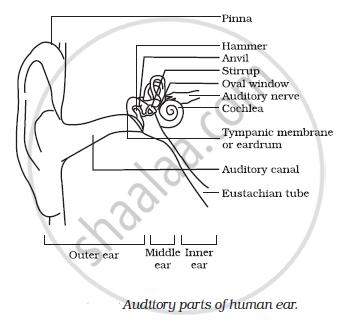Advertisements
Advertisements
प्रश्न
Explain how the human ear works.
उत्तर
Different sounds produced in our surroundings are collected by pinna that sends these sounds to the ear drum via the ear canal. The ear drum starts vibrating back and forth rapidly when the sound waves fall on it. The vibrating eardrum sets the small bone hammer into vibration. The vibrations are passed from the hammer to the second bone anvil, and finally to the third bone stirrup. The vibrating stirrup strikes on the membrane of the oval window and passes its vibration to the liquid in the cochlea. This produces electrical impulses in nerve cells. The auditory nerve carries these electrical impulses to the brain. These electrical impulses are interpreted by the brain as sound and we get a sensation of hearing.

APPEARS IN
संबंधित प्रश्न
Lightning and thunder take place in the sky at the same time and at the same distance from us. Lightning is seen earlier and thunder is heard later. Can you explain?
Mention the exact location of the Eustachian tube
Differentiate between members of the following pair with reference to what is asked in bracket.
Dynamic balance and static balance (Definition)
Name the three tiny bones present in the middle part of ear.
Give the main function of the following:
Cochlea
Draw a labeled diagram of the inner ear. Name the part of the inner ear that is responsible for static balance in human beings.
Given below is the diagram of the human ear. Study the diagram and then answer the questions that follow:

(i) What role does the eardrum play in hearing?
(ii) What common term is given to the parts labeled A, B, and E?
(iii) Would there be any difference if these three parts mentioned in (ii) above were replaced by one by one? Why?
(iv) Give the biological term for the parts labeled C and D.
(v) Name the fluid which fills the parts mentioned in (iv) above.
(vi) State the functions of the ear.
State the Location:
Semicircular canals
Which of the following structures equalises the air pressure on either side of the tympanum?
With reference to human ear answer the question that follow:
Name the part of the ear associated with Static balance.
